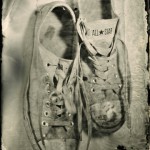Many photographers today are reviving the photographic processes of the Civil War era. A California news article reports on several photographers in San Francisco who are producing photographs with the wet-plate process. Even Louis Vuitton highlights wet-plate photography in his digital project Double Exposure for the Fall/Winter 2011/2012 ad campaign. Notice how both the news article and film clips emphasize the portrayal of character in wet-plate photography. What do you think are some reasons for the nostalgic return to nineteenth-century processes?
Read the article on San Francisco-area photographers here:
Watch a video on Sam Taylor-Woods, one of the photographers on the Vuitton campaign:
Explore the official site of Louis Vuitton’s Double Exposure campaign on Facebook:





Everyone and their mother has a point and shoot camera, and they all use it. With that, it’s somewhat hard to tell the truly talented photographers from the average joe that just happens to catch a lucky shot. However, with the wet paint process, it requires real experience so practitioners will get the praise they deserve. Which, not all, but some photographers do seek and need.
A different reason may be that photographers are just expanding on their skills. Many that have ‘mastered’ point and shoot photography simply get bored, and want to tackle the challenge of the wet plate collodion process.
Personally I like this process as opposed to P&S, and not just because I prefer black and white pictures to color, but also because it requires true work. Not taking anything from professional P&S photographers, but wet plate photographers have to do what P&S photographers do, and more. I’m willing to bet though that they have no complaints, because the final products are worth it.
Hard work pays off, and the wet-plate/tintype processes really show it. The struggle and passion used to create these works cannot be replicated by any sepia or filters that our modern day cameras come equip with.
That said, just because you use these difficult processes, it doesn’t automatically make the photo a masterpiece. Take for example the Converse still life shown in the article. Honestly, the “magic” of the tintype shouldn’t be wasted on a trivial photo we can see hundreds of if we Google Images “Converse”. I personally don’t notice any specialty or nuance in this that I see in the stills of Heather and Barry Jenkins.
Or maybe I just don’t have an eye for art. -eye roll-
Several possibilities come to my mind. They really appreciate photography in all that it is/was and wish to revive and be a part of how it all started. The outcome of the photographs are unique that all the imperfections are perfections in their eyes. It is more gratifying as you have to go through the whole process of creating just one photograph. They enjoy bonding with the camera to produce art. Just like film camera, you really do have to spend more time taking a photograph. You don’t want to be trigger happy and waste film since it can be costly.
Unlike the point and shoot cameras, the wet-plate process takes practice and “practice makes perfect.” None of our modern day cameras or programs like Photoshop is needed to create this ancient look, just the use of your patience, practice, and chemicals in order to make a ‘perfect haunting quality image that will be hard to replicate.’
In my personal experience, working in a dark room with black and white photography was fascinating. So I can probably see why so many photographers are following the old wet-plate process trend. It’s a nice feeling being able to say I took and made this photograph. Not just I took this photograph. It’s like comparing Digtal v.s. Film to microwave v.s. cooking. They both do the same thing but the taste and feel of it will be totally different. The point and shoot camera and the program that you use is what makes your image better but in dealing with film or the wet-plate process, you, yourself are making your image better by the use of these chemicals.
Like Corey Keller explains in this article, “Right now there’s an angst about digital photography and a proliferation of nostalgia.” And I think this is so true no matter how many new technologies emerged, we will always long for the old things at one point or another. I mean I know of people who still own or collect Palaroid cameras and take photographs with them as a hobby. Same goes for our world of advertisement, in fashion, for some reason we always tend to go back to old trends from the past.
It’s interesting to know that these type of photographs are still being made in our present time. In the past, I have played with these types of filters adding the ‘old’ effect to my photos. It makes me wonder what they would look like and how different they would be if at all different when developed the true old fashion way using wet-plates.
Just like the old sneaker shoes were brought back to life, so too I think enthusiasts are bringing back to life the old process of photography. It gives these photographers an edge and uniqueness to todays artists making them stand out from the masses.
I think its amazing that many photographers still use wet-plate/tintype processes because it shows appreciation for photography and there’s a raw quality that its incomparable to digital. I’m an SLR shooter and I like the results that I get for the type of photography that I do but if I could afford the old school method, I would love to pay my dues and achieve awesome results such as Robert Christian Malmberg’s “Converse sneakers” ad campaign.